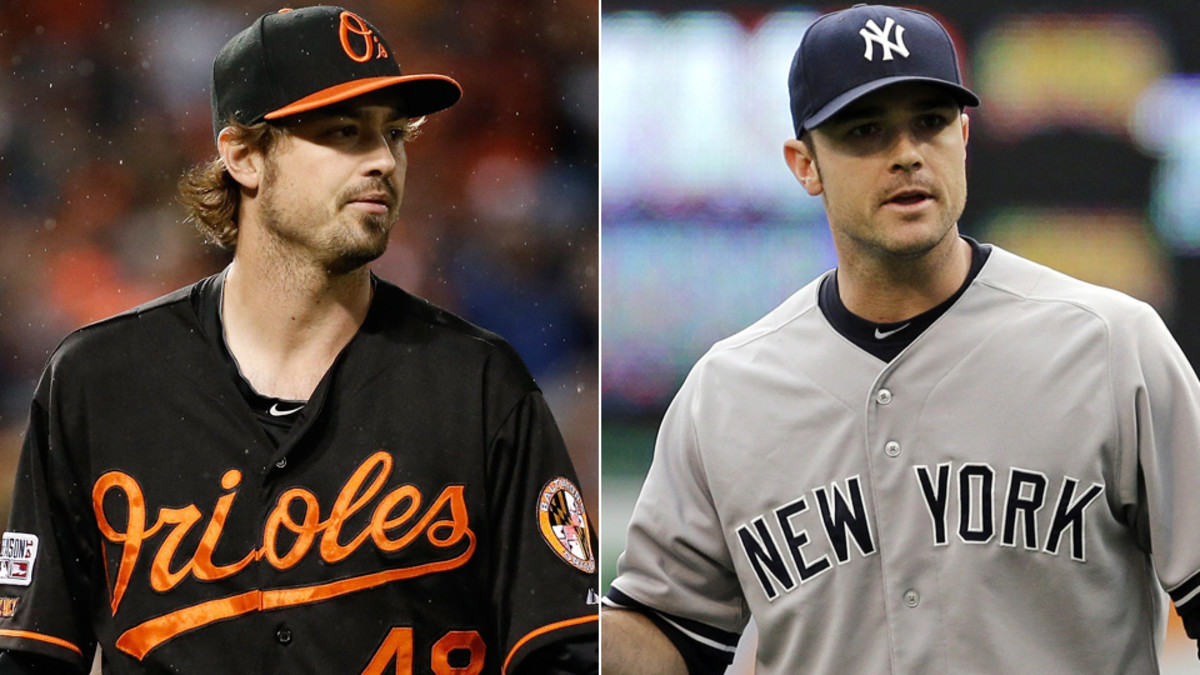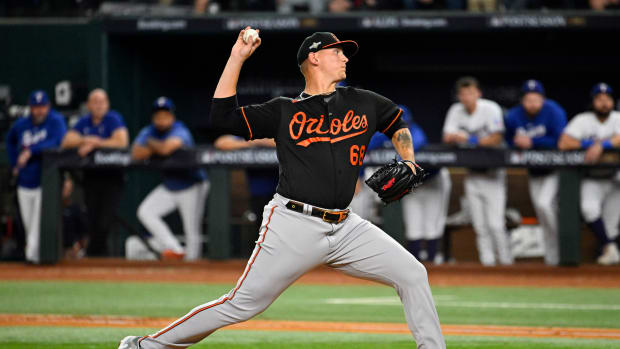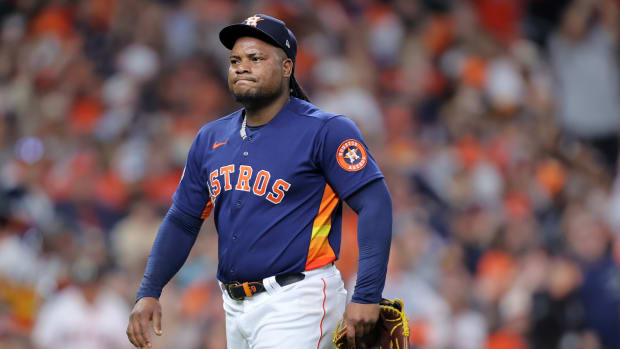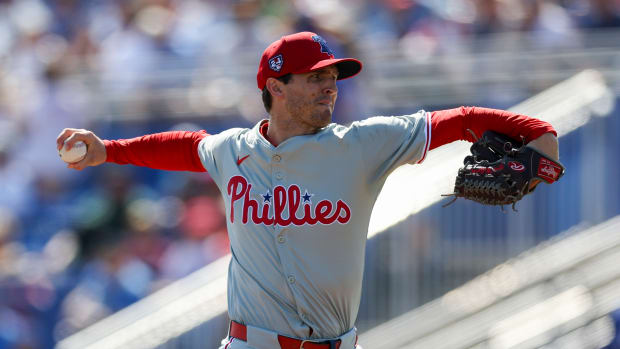
Robertson or Miller? Picking free agency's best bullpen option
Though many of this offseason's best free-agent position players have signed already—including six of the top seven hitters on Ben Reiter's list of the top 50 free agents — the pitching market has once again been slow to develop. There's a growing sense, however, that the dominoes are about to tumble, at least with regard to the top two relief pitchers on the market.
Indeed, Andrew Miller, a lefthander who was dominant for the Orioles down the stretch this past season, and David Robertson, an All-Star setup man who replaced the retired Mariano Riveara as the Yankees closer last year, have been hot topics on the rumor mill of late. Miller has reportedly received multiple three-year offers while narrowing his options to eight teams from the 22 originally vying for his services; he is said to be close to making a decision. Robertson, meanwhile, is reported to have received a three-year offer worth $39 million from an unnamed team. The speculation is that both pitchers will end up with four-year contracts, prompting us to wonder which pitcher is the better investment.
• Free-agent tracker: Keep up with the latest signings
Three Strikes: Craving hitters, PED update and more change in Oakland
The trick here is that Miller, having compiled exactly one save in his nine-year career to Robertson's 47 (39 of which came in 2014), is going to be less expensive. Despite the progress the game's general managers have made over the past decade or so, the market still rewards pitchers for being "established closers." Robertson, having spent exactly one season in that role, now qualifies as one, while Miller does not. For that reason, the Yankees knew they could extend Robertson a qualifying offer to Robertson, which he declined, without negatively impacting his desirability on the open market.
The Orioles didn't have the option of doing the same for Miller, whom they acquired from Boston at the trading deadline, because players traded midseason are ineligible for qualifying offers. As a result, Robertson will cost any team but the Yankees its top unprotected draft pick, while Miller can be signed for less money and without surrendering a pick. All things being equal, that strongly favors Miller, but how close are all other things to being equal?
To begin with, the two are effectively the same age. Robertson will turn 30 on April 9, Miller on May 21. Miller, by virtue of being a first-round pick (sixth overall by the Tigers in 2006) who signed a major league deal, got to the bigs faster. He has also thrown more innings, thanks to spending most of his first six seasons as a starter. But because of his struggles in that initial role, he never threw more than 142 innings a season in the majors and minors combined, and his 492 2/3 MLB innings aren't that much more than Robertson's 393 1/3. Robertson, meanwhile, has been in far more games, 402, compared to Miller's 259 (not counting postseason appearances). As a result, there's no good reason to favor one pitcher over the other based on age or workload.
Mariners finally get righthanded power bat with Nelson Cruz signing
The same is true with regard to their injury histories. Miller has hit the disabled list five times, but none of those trips were arm-related, and three of them were in 2009 or earlier (hamstring and oblique strains and patellar tendinitis). He did miss most of 2013 due to a Lisfranc tear in his left foot, which required season-ending surgery, but that was a fluke injury which had no impact on his 2014 campaign, in which he appeared in 78 games between the regular and postseasons. Robertson had a bit of shoulder tendinitis in late 2013, but it did not re-occur in 2014, nor have the back spasms he experienced in late 2010. He has gone on the disabled list twice, for an oblique strain in 2012 and a groin strain in April of this past season.
The largest and most obvious difference between the two pitchers is that Robertson is a short righty (listed at 5-foot-11) and Miller is a tall lefty (listed at 6-7). Being a southpaw is no obstacle to Miller's potential as a closer, however. Check out how the splits for the two of them over the past two seasons:
Pitcher | Vs. LHB | Vs. RHB |
Miller | .208/.258/.309 | .148/.270/.203 |
Robertson | .166/.236/.225 | .245/.311/.418 |
A's trading Josh Donaldson to Blue Jays signals shift toward rebuilding
Consistency is actually Robertson's primary advantage over Miller. A reliever throughout his professional career, Robertson has been essentially the same pitcher for all seven of his major league seasons. He throws a low-90s fastball, one typically described as sneaky-fast due to the deception in his delivery and the pitch's movement (which often results in it being classified as a cutter), and a nasty curve. He'll mix in a handful of changeups over the course of the season just to keep hitters on their toes, but it's pretty much just fastballs and curveballs.
As for Miller, he had four pitches as a starter but now throws just a mid-90s fastball and a slider in almost equal measure. The fastball reaches 98 miles per hour, but the slider is his best pitch. It's just as vicious diving down and in on righties as down and away from lefties, and it resulted in a swing-and-miss more than a quarter of the time in 2014, which was slightly more often that Robertson's curve.
Both men have used their repertoires to rack up impressive strikeout rates. Robertson has struck out 32 percent of the batters he has faced in his career. Among pitchers with 200 or more innings pitched since 2008, only Aroldis Chapman (43.3 percent), Craig Kimbrel (42.2 percent), Kenley Jansen (39.3 percent) and Greg Holland (34.5 percent) have a higher strikeout percentage. Over the last three years, Miller has struck out 37 percent of the batters he's faced. Those are Miller's first three seasons as a pure reliever, and he has been very much Robertson's equal over that span. Here's a full comparison:
pitcher | era | era+ | k% | k/9 | BB/9 | K/BB | WHIP | FIP |
Robertson | 2.59 | 156 | 33 | 11.9 | 2.8 | 4.23 | 1.09 | 2.59 |
Miller | 2.57 | 158 | 37 | 13.6 | 3.6 | 3.74 | 1.05 | 2.37 |
Thus all things here aren't exactly equal, but they're shockingly close. Robertson, who walked 4.7 men per nine innings in his first four big-league seasons, has matured to have better control, but one could argue that Miller did the same last year, walking just 2.5 men per nine innings to Robertson's 3.2.
How Sandoval and Ramirez deals shake up free-agent market
All told, Robertson's consistency makes him the better investment, but because Miller will come cheaper and without the added cost of a draft pick, he should be primary target for teams looking for a relief ace this offseason. One such team is the Yankees, who would gain a draft pick by signing Miller and letting Robertson sign elsewhere. Chances are, a year from now, Miller will be as "established" and dominant a closer as Robertson already is, and he'll still be cheaper.


































